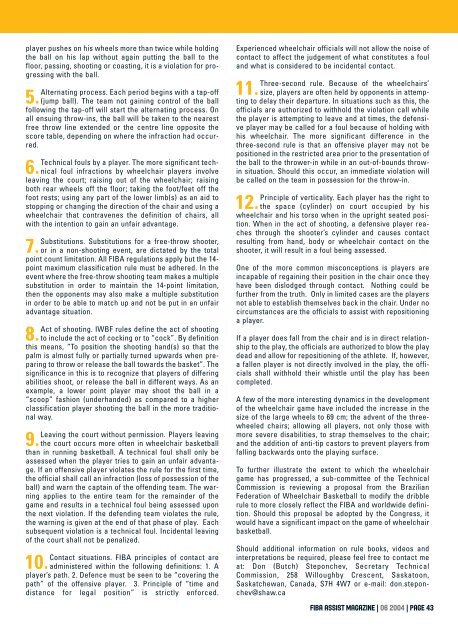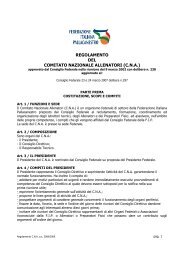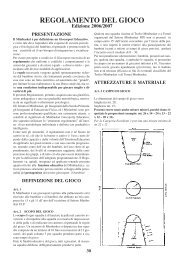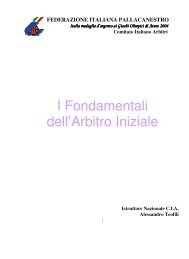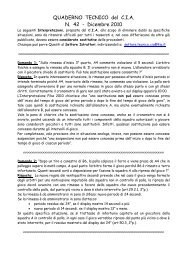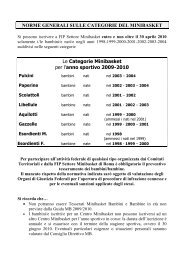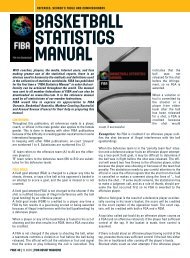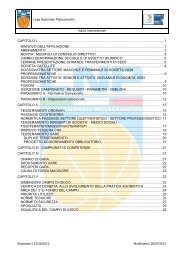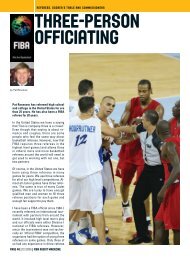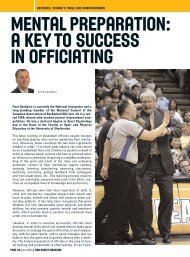OFFICIATING OF WHEELCHAIR BASKETBALL - Fiba
OFFICIATING OF WHEELCHAIR BASKETBALL - Fiba
OFFICIATING OF WHEELCHAIR BASKETBALL - Fiba
Create successful ePaper yourself
Turn your PDF publications into a flip-book with our unique Google optimized e-Paper software.
player pushes on his wheels more than twice while holding<br />
the ball on his lap without again putting the ball to the<br />
floor, passing, shooting or coasting, it is a violation for progressing<br />
with the ball.<br />
Alternating process. Each period begins with a tap-off<br />
5. (jump ball). The team not gaining control of the ball<br />
following the tap-off will start the alternating process. On<br />
all ensuing throw-ins, the ball will be taken to the nearest<br />
free throw line extended or the centre line opposite the<br />
score table, depending on where the infraction had occurred.<br />
Technical fouls by a player. The more significant tech-<br />
6. nical foul infractions by wheelchair players involve<br />
leaving the court; raising out of the wheelchair; raising<br />
both rear wheels off the floor; taking the foot/feet off the<br />
foot rests; using any part of the lower limb(s) as an aid to<br />
stopping or changing the direction of the chair and using a<br />
wheelchair that contravenes the definition of chairs, all<br />
with the intention to gain an unfair advantage.<br />
Substitutions. Substitutions for a free-throw shooter,<br />
7. or in a non-shooting event, are dictated by the total<br />
point count limitation. All FIBA regulations apply but the 14point<br />
maximum classification rule must be adhered. In the<br />
event where the free-throw shooting team makes a multiple<br />
substitution in order to maintain the 14-point limitation,<br />
then the opponents may also make a multiple substitution<br />
in order to be able to match up and not be put in an unfair<br />
advantage situation.<br />
Act of shooting. IWBF rules define the act of shooting<br />
8. to include the act of cocking or to “cock”. By definition<br />
this means, “To position the shooting hand(s) so that the<br />
palm is almost fully or partially turned upwards when preparing<br />
to throw or release the ball towards the basket”. The<br />
significance in this is to recognize that players of differing<br />
abilities shoot, or release the ball in different ways. As an<br />
example, a lower point player may shoot the ball in a<br />
“scoop” fashion (underhanded) as compared to a higher<br />
classification player shooting the ball in the more traditional<br />
way.<br />
Leaving the court without permission. Players leaving<br />
9. the court occurs more often in wheelchair basketball<br />
than in running basketball. A technical foul shall only be<br />
assessed when the player tries to gain an unfair advantage.<br />
If an offensive player violates the rule for the first time,<br />
the official shall call an infraction (loss of possession of the<br />
ball) and warn the captain of the offending team. The warning<br />
applies to the entire team for the remainder of the<br />
game and results in a technical foul being assessed upon<br />
the next violation. If the defending team violates the rule,<br />
the warning is given at the end of that phase of play. Each<br />
subsequent violation is a technical foul. Incidental leaving<br />
of the court shall not be penalized.<br />
Contact situations. FIBA principles of contact are<br />
10. administered within the following definitions: 1. A<br />
player’s path. 2. Defence must be seen to be “covering the<br />
path” of the offensive player. 3. Principle of “time and<br />
distance for legal position” is strictly enforced.<br />
Experienced wheelchair officials will not allow the noise of<br />
contact to affect the judgement of what constitutes a foul<br />
and what is considered to be incidental contact.<br />
Three-second rule. Because of the wheelchairs’<br />
11. size, players are often held by opponents in attempting<br />
to delay their departure. In situations such as this, the<br />
officials are authorized to withhold the violation call while<br />
the player is attempting to leave and at times, the defensive<br />
player may be called for a foul because of holding with<br />
his wheelchair. The more significant difference in the<br />
three-second rule is that an offensive player may not be<br />
positioned in the restricted area prior to the presentation of<br />
the ball to the thrower-in while in an out-of-bounds throwin<br />
situation. Should this occur, an immediate violation will<br />
be called on the team in possession for the throw-in.<br />
Principle of verticality. Each player has the right to<br />
12. the space (cylinder) on court occupied by his<br />
wheelchair and his torso when in the upright seated position.<br />
When in the act of shooting, a defensive player reaches<br />
through the shooter’s cylinder and causes contact<br />
resulting from hand, body or wheelchair contact on the<br />
shooter, it will result in a foul being assessed.<br />
One of the more common misconceptions is players are<br />
incapable of regaining their position in the chair once they<br />
have been dislodged through contact. Nothing could be<br />
further from the truth. Only in limited cases are the players<br />
not able to establish themselves back in the chair. Under no<br />
circumstances are the officials to assist with repositioning<br />
a player.<br />
If a player does fall from the chair and is in direct relationship<br />
to the play, the officials are authorized to blow the play<br />
dead and allow for repositioning of the athlete. If, however,<br />
a fallen player is not directly involved in the play, the officials<br />
shall withhold their whistle until the play has been<br />
completed.<br />
A few of the more interesting dynamics in the development<br />
of the wheelchair game have included the increase in the<br />
size of the large wheels to 69 cm; the advent of the threewheeled<br />
chairs; allowing all players, not only those with<br />
more severe disabilities, to strap themselves to the chair;<br />
and the addition of anti-tip castors to prevent players from<br />
falling backwards onto the playing surface.<br />
To further illustrate the extent to which the wheelchair<br />
game has progressed, a sub-committee of the Technical<br />
Commission is reviewing a proposal from the Brazilian<br />
Federation of Wheelchair Basketball to modify the dribble<br />
rule to more closely reflect the FIBA and worldwide definition.<br />
Should this proposal be adopted by the Congress, it<br />
would have a significant impact on the game of wheelchair<br />
basketball.<br />
Should additional information on rule books, videos and<br />
interpretations be required, please feel free to contact me<br />
at: Don (Butch) Steponchev, Secretary Technical<br />
Commission, 258 Willoughby Crescent, Saskatoon,<br />
Saskatchewan, Canada, S7H 4W7 or e-mail: don.steponchev@shaw.ca<br />
FIBA ASSIST MAGAZINE | 06 2004 | PAGE 43


